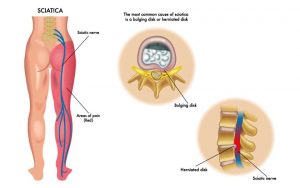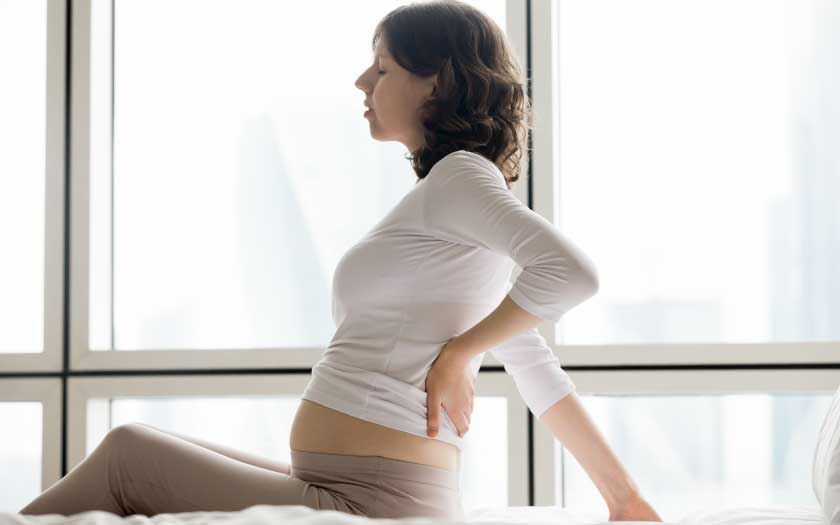Sciatica is a shooting pain that can be felt in the lower back and also down your buttocks and the back of your leg. It’s caused by the compression of the sciatic nerve, which runs through that area of the body.
This condition is quite common among pregnant women, especially during the second and third trimesters when the growing fetus puts pressure on the sciatic nerve.
No ordinary pain
There are the usual pain and aches due to pregnancy, and there’s sciatica pain, which is different from other back pain or leg pain. The pains from sciatica are sharp and shooting. They tend to run down the leg, sometimes starting from the buttocks. You can have sciatica with or without backache and it can send pain down one of your legs. It may also be felt down the outer side of your calf to your foot and toes.
It might surprise you to know that sciatica is not only quite common among pregnant women, but also that every pregnant woman would probably experience some sort of sciatica pain at least once during the duration of their pregnancy.
Did you know?
Sitting for long and poor posture apparently can lead to sciatica. So, if you’re pregnant, try to stay as active as you can.
(check with your doctor if you intend to enroll in an exercise program).

Your doctor may refer you to a *musculoskeletal physiotherapist. Ask if you can see one who specialises in women’s health or pregnancy health. The physiotherapist will guide you in the best ways to beat the pain, which usually includes exercises to strengthen your pelvic floor, tummy muscles, and back. You’ll also be shown ways to improve your posture. Follow-up check-ups may be necessary throughout your pregnancy to check the function of your nerves.
In most cases, results can be felt 10 days to two weeks. Even pregnant women with acute sciatica may recover within four weeks to 12 weeks with proper treatment and consistency in their exercises. For some though, it may take longer.
Pain medication for sciatica
You may have a high threshold for pain, but as mentioned earlier, sciatica is no ordinary pain and sooner or later you may find yourself seeking some relief from those shooting pains down your lower body. As the most common painkiller, paracetamol is relatively safe for pregnant women, although it’s always better to ask your doctor or a pharmacist about how much to take and for how long.
*A musculoskeletal physiotherapist specialises in treating injuries and conditions which affect the muscles, joints, and soft tissues.
Self-help methods to ease sciatica
Hot or cold compresses. Apply a heat pack and an ice pack at alternate times to the painful area to help reduce the pain. Remember though to avoid placing any kind of hot or cold packs directly on your skin — Use a light towel or flannel cloth as a buffer first. This alternating between hot and cold compresses works for many women.
Move around! There is a difference between resting and being in bed or even sitting down for too long. Remaining sedentary for too long may lead to sciatic nerve pains or worsen an already existing condition. Move around as much as you possibly can.
Keep your posture in check. Watch your posture and for as much as possible, keep your back slightly and comfortably arched. Keep a maternity pillow or even a rolled-up towel at hand to help support your spine whenever you’re seated.
No lifting heavy items. Avoid it as much as possible. If you do have to lift something and there is no one around to lend you a hand, bend from your knees and keep your back straight. Keep the object you’re lifting close to your body.
Listen to your body. If an activity you’re doing seems to worsen your sciatic pains, stop doing it at once, and try avoiding that particular activity in
the future.
Sleep on your side. Use a pillow or two tucked between your knees. Note: maternity pillows will help. Sleeping on your side is best for your baby — by the third trimester, it reduces your risk of complications compared to lying on your back.
Wear comfortable shoes. You may not realise it but the impact of walking increases the jarring of your spine, which may make your pain worse. Comfortable shoes with a special insole that help absorb impact may help.
Try a maternity girdle, belt, or band. These are quite comfortable to wear and they help to lift the uterus a little bit and distribute the weight more evenly, and in doing so, provide relief from sciatic pains.
Sciatica after a baby
For some women with sciatica during their pregnancy, the condition may remain even after giving birth. As with any condition that involves the spine, posture is important when standing, walking, and sitting. In this case, it also includes posture while breastfeeding or bottle-feeding, for you’ll be holding your baby and sitting down for quite some time. It’s important to feel at ease and comfortable when you’re nursing your baby, so try out different positions until you determine which is best for you.
During night feeds, particularly if you breastfeed, try lying on your side, with your painful side up. This relieves the pressure on your spine, which can help provide some relief from sciatic pains. Laid-back breastfeeding may help too, as your baby is supported on your body. If you prefer to breastfeed in a sitting position, sit on a straight-backed chair. Raise your baby to your breast with a pillow or cushion and keep your feet flat on the floor.
When changing your baby’s diapers, try to get the job done on a changing station rather than on the floor. Remember too that when you’re
lifting your baby, keep your back straight, bend your knees, and avoid twisting movements.
Keeping generally active will help to prevent sciatica from becoming a long-standing issue, so do consult your doctor or even a certified yoga practitioner for advise on the best kinds of exercise to help you deal with sciatica and hopefully, make it a thing of the past.


